HEADING WEST: MAY 31. 2006
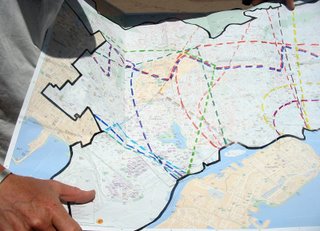
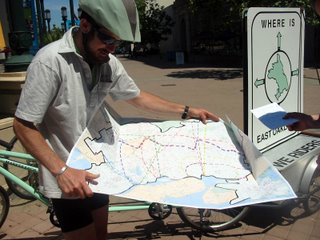
WE Riders is a creative research project to give West & East Oakland residents a chance to culturally define, physically locate, & celebrate their neighborhoods through stories & images that will be collected & displayed on a trailer-kiosk towed by tandem bicycle.



 Lafayette Square Park
Lafayette Square ParkWe were very curious about where the borderline between the West and downtown might be. First we rode to Lafayette Square Park (10th and Martin Luther King), which dates back to Oakland’s earliest days. Nicknamed “The Old Man’s Park”, Lafayette Square underwent a major revitalization in 1999 after suffering for years as a drug dealing hotspot. At the opening of the event, people were very excited by the park’s potential: ``We said `no' to sweeping the poor out,'' Eller-Issacs said to rounding applause. ``That's not the way to rebuild a park. You make it a place for all people. This is a new beginning for Oakland.'' Learn more about the park’s reopening by reading the 1999 article in SF Gate.
When we arrived on the scene, it was shortly before noon.We rode around the park, impressed by its attractive seating (tables with embedded chess boards surrounded by chairs), sweeping old oaks and inviting play area.We were very surprised at how abandoned and empty the park seemed to be: all of ten people were using the space; several men gathered at one of the benches eyed us with inquisitive grins and a few other homeless folks were camped out with their carts. With its proximity to City Hall and the Federal Building, we thought this would be a popular lunch spot.We were wrong. It seemed like Jefferson Street was profound boundary; people walked around east of the Federal Building but not west of it. We also considered that the park might have more people in the later afternoon after school is out.
Then Michael came rolling up to us on his long, tricked out easy-rider bike. Turns out that he made this amazing bike from a combination of constructed and purchased parts. Michael had plenty of time to spare, and in order to acurately answer our question about where West Oakland is, he shared some of his life story with us. Seemed that in order to understand his perspective on where he lives, we needed to know something about where he came from.  Michael came to West Oakland with his mother and brothers from Louisiana:
Michael came to West Oakland with his mother and brothers from Louisiana:
“My whole family lived here in West Oakland, but everyone was scared; I had to walk my baby brother to and from school. There were lots drugs and gangs. They all moved away. I’m still here!”
Michael's southern calm shone through as he laughed about the danger of the area. He told us that he grew up on a farm with chickens and hogs. But wolves, panthers and snakes surrounded the farmland:
“But I was the brave one! When I was 7-8 years old, there was this big ol’ thunderstorm. We kids was all in the house alone. We needed water and someone had to go out to the well. So I went! I wasn’t scared of nothing. Me and my dog Trouble...”
Michael told us that West Oakland went from 7th and Clay all the way to the West Oakland Pier.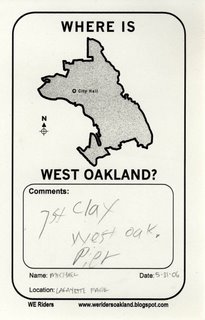
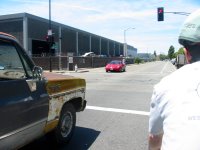 Heading to West Oakland BART Station:
Heading to West Oakland BART Station:
 West Oakland BART Station:
West Oakland BART Station:As we set up, we noticed that people had a sense of reservation. People walked by the kiosk giving us a wide berth. We tried approaching some people without much luck. We talked to the hot-dog vendor who told us, "I don't know maps. I know I'm in West Oakland but I don't know where that is." When we asked him some more questions, he gruffly told us, "Hey, I'm busy-there're customers I need to help." No one else was around and before too long he emerged from his booth and sat down across from us, drinking a soda. Still no more comments. When we asked a BART janitor about where West Oakland might be, she said, "People don't know! That's crazy because its nice here."
The last person we spoke with, a very cautious guy, wanted to know how to tell the directions without a compass. Luckily it was just past noon, so we could use the sun's shadow to help us find north.
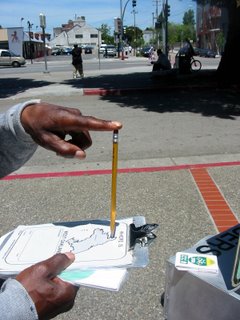 We realized that we probably would not have anymore interactions with folks here; the few commuters that were around were busy with getting to and from and did not want to engage with us. We distributed some City bike info. We concluded that we might have a better chance at talking to people at a different time of day.
We realized that we probably would not have anymore interactions with folks here; the few commuters that were around were busy with getting to and from and did not want to engage with us. We distributed some City bike info. We concluded that we might have a better chance at talking to people at a different time of day. Oakland Green:
Oakland Green:Some of you may be wondering about the color scheme for the WE Riders project. We have chosen to use a very specific green color for our bike, the trailer, and our uniform logos, a color that we have referred to as “Oakland Green”. All Oakland City vehicles used to be this color. With the recent City budget crisis, nearly all City vehicles are now a generic (and inexpensive) white. However, on our ride back home, we spied one of the few remaining City vans painted this brilliant Oakland Green.


As we were setting up the bike and kiosk, we attracted the attention of a group of high school kids having their lunch. They are from the Lighthouse Charter School located a few blocks from City Hall. They take their lunch at the plaza everyday. At first the kids were shy about writing their responses, but soon they came over to the trailer to look at the map. Then their teacher followed, and they had an impromptu geography lesson. When the teacher asked what you can use if don't know 'north', 'south', 'east' and 'west', one of the girls coyly, "My daddy! He knows everything!" The teacher looked chagrined and said, "No, the sun!" Most of the kids are from East Oakland. A few of them warned us: "Don't go riding there---it's dangerous!" Here are some of their drawings: (To see all of the drawings we collected today, click on the flickr on the right side of the page.)
WE Riders: Can you help us find West and East Oakland?
Passer-by: I thought you were going to educate me!
Commenting on the outline of the city's shape: 'It's weird to see the city this way.'
'It takes ten years of living here to begin to know where West & East Oakland are. The most easterly point (indicating on the map) is not East Oakland.'
'Where are the borders? Does downtown count? It's confusing!'
'East Oakland is towards the 'hundreds' (streets). West Oakland is that way (pointing roughly west).'
'West Oakland? That's easy! Just follow the sun...'
'Why is downtown called downtown?'
'I live west of Oakland and take BART to downtown for work. I walk five blocks during lunch and then go back to work. To go to West Oakland, I'd say take the BART to the West Oakland station. Then you're there. East Oakland? I don't know where that is. I don't know any of the surface streets. That's all I know of Oakland!'
A lot of people were commenting on how strange it was that East Oakland was really in the south. We started asking people why they thought that was and if they thought there was a reason why we don't have a South Oakland region designated. Here's what people had to say:
'There are historical reasons. When Oakland first started it was just in this central downtown area. What we know as West and East Oakland were their own little communities and towns separate from Oakland.'
'You're driving south on the freeway heading towards East Oakland and then the freeway turns east.'
'West Oakland is really west but East Oakland is really south. East Oakland is called East because if you look on the map, it is directly opposite from West Oakland. I don't know why it is this way. People are really weird.'


We have been using the "Walk Oakland" map as a reference guide in our kiosk. This great map includes all existing bike routes in the city and also, importantly, shows the grades of all roads: very helpful info for planning your eco-adventure. On the back of the map you find all kinds of tid-bits about Oakland local history. You can find this map for sale at Cody's (4th Street), Piedmont Office Supply (Piedmont Ave.), Laurel Books 4100 MacArthur Blvd.). Just by coincidence, we had set up our kiosk ride below the office window of the creator of this map, Jason Patton. Before he revealed his identity, he asked us some questions about the project----he just kept on grinning as we told him more, especially about how important it is for us to promote local ecotourism and make use of Oakland's new bike lanes. He was happy to see us use his map and told us that he will soon be issuing a third edition that will include more specific info about bike lanes.
We took advantage of being able to talk to an 'expert' about the city and he told us this about West and East Oakland:
'West Oakland is clearly defined, unfortunately by the 580 and 980 Freeways and also the Port. East Oakland is more subjective: some people think it is anything east of the lake, some people say the hills and others include Fruitvale. The City's designation on internal maps bounds these regions with fuzzy edges. A lot the distinctions rest on social, racial and class issues.'
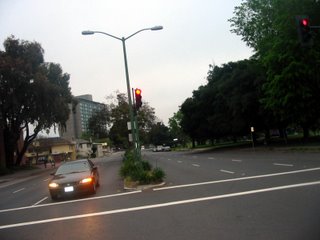
 It was still dark when we woke at 5:30AM to prepare for the BTWD event. The weather was typical of summer: heavy dampness embraced by thick fog. We had hoped for brilliant sun as in recent mornings, but at least it wasn’t raining. After gathering our supplies and putting on our new uniforms, we groggily set off for Downtown. Our friend Birgit created these great monogrammed helmet covers. We are sure that we are starting the next big trend!
It was still dark when we woke at 5:30AM to prepare for the BTWD event. The weather was typical of summer: heavy dampness embraced by thick fog. We had hoped for brilliant sun as in recent mornings, but at least it wasn’t raining. After gathering our supplies and putting on our new uniforms, we groggily set off for Downtown. Our friend Birgit created these great monogrammed helmet covers. We are sure that we are starting the next big trend! Setting up at Frank Ogawa Plaza
Setting up at Frank Ogawa PlazaAfter riding through very quiet downtown Oakland streets, we arrived at City Hall at 6:30 AM, greeted by caffeinated frenzy. The BTWD organizers were so excited to see us that we told first, we must set-up over here and then, over there. There was a table already assigned to us, so we had our spot. We folded up the table to have adequate space for the kiosk and participants. We stenciled the area surrounding the kiosk. To our left was Ride Home, an organization offering rides to troubled bikers (guaranteeing a ride home from work when unexpected circumstances arise) and across from us were the folks from the Park District. BART, AC Transit info booths as well as bike repair services and the East Bay Bike Coalition were all on hand. Even before 7AM, eager bikers were walking around with bikes in tow.
We learned about interesting summer bike tours of Oakland sponsored by the Oakland Museum: "Explore Oakland with the docents of the Oakland Museum and learn about the incredible history of Oakland and its visionaries and scoundrels--who were often the same people." The tours leave the museum at 10AM the third Sunday of each month. The tours are about 5 miles long (no hills!) and last 2 hours and they are FREE! We will definitely take part in one of these great offerings. Call 510-238-3514 to reserve a spot.
It didn’t take too long for BTWD attendees to realize that we weren’t like the other booths at the event. A few walked by with quiet curiosity. Soon, we were talking to loads of people who wanted to know what we were up to. As we explained the project, people were eager to help us with information concerning the whereabouts of West and East Oakland. By the end of the two-hour event, we had spoken with a diverse group of over forty people.Here are some of their comments:
'I'm a teacher at Fremont High School and I talk to my students about the all the time---we're actually in the south not the east because the bay runs southeast.'
'Where are West and East Oakland? Stay above the 580. Homicide is a big worry.'
'Thumbs up to ecotourism!!'
'I really have no idea---is there a there there?'
'You know you are in East Oakland when the street names change---You know, to First Ave and so on.'
‘Are you going to change the neighborhood names?’
Q: ‘Do you want to give your opinion about where West and East Oakland are?’
A: ‘No, I live there—I’m cool.’
‘They never put the neighborhood names on the map. And if they do, they’re wrong.’
‘West Oakland is easy: that’s where the West Oakland BART station is.’
'People identify with their neighborhoods, but above the 580, people don't say they live in East Oakland.'
'I'm scared to say! I have a terrible sense of direction.'
‘Do you have maps that show where West and East Oakland are?’
‘Good question---people are always talking about different places when they say West Oakland or East Oakland.’